recibido: 12.01.2017 / aceptado: 22.01.2017
Nuevos hábitos en la gestión
fotográfica en smartphones
New habits in smartphones
photo management
Andrés Fraga Pérez
Universidade de Santiago de Compostela
Maria Azul Forti Buratti
Universidad Autónoma de Madrid
Referencia de este artículo
Fraga Pérez, Andrés y Forti Buratti, Maria Azul (2017). New habits in smartphones photo management. adComunica. Revista Científica de Estrategias, Tendencias e Innovación en Comunicación, nº13. Castellón: Asociación para el Desarrollo de la Comunicación adComunica y Universitat Jaume I, 135-156. DOI: http://dx.doi.org/10.6035/2174-0992.2017.13.8.
Keywords
Snapshot; smartphone; photography; cloud storage; photo management; authorship.
Palabras clave
Fotografía; fotografía doméstica; teléfono inteligente; almacenamiento en la nube; archivo; autoría.
Abstract
This article study the habits in the use and manage of smartphone images. Being smartphones the most universal product, and their camera a key element, this research is bases on the hypothesis that current photo habits exceed mobile photo manage tools. A survey to smartphone users sought a general view of current situation about their photographic habits in the taking, manage and store of photos inside their phones. The survey also has questions about the long term expectations. Results show lack of adequacy of current systems to smartphone pictures and open a discussion about how to adapt current photo manage systems to a long term vision.
Resumen
En este artículo se revisan los hábitos de uso y gestión de las fotografías en los teléfonos inteligentes. En un momento en que el smartphone es el producto tecnológico más universal siendo su cámara de fotos uno de sus elementos más importantes, se plantea la hipótesis de que los actuales hábitos fotográficos de los usuarios desbordan la capacidad de gestión de los sistemas operativos y las aplicaciones móviles. Para obtener una mejor visión de la situación actual se realizó una encuesta a usuarios de smartphone acerca de sus hábitos en la captura y gestión de las imágenes, propias y ajenas, dentro del teléfono, preguntando también sobre sus expectativas de futuro de cara al uso y almacenamiento a largo plazo de esas imágenes. Los resultados muestran una falta de adecuación de los actuales sistemas de gestión y almacenamiento de imágenes en smartphone al largo plazo, profundizando en los problemas que la llegada de la cámara compacta digital supuso en la gestión de la fotografía personal y familiar, y que están ampliamente documentados. Los resultados de este estudio invitan a una reflexión sobre cómo adaptar los actuales sistemas de gestión fotográfica a una visión a largo plazo en el ámbito personal.
Autores
Andrés Fraga Pérez [andres.fraga@usc.es] es graduado en Fotografía y Creación Digital por la Universitat Politècnica de Catalunya y máster en Comunicación y Creación Industrial de la Universidade de Santiago de Compostela. Es doctorando en Comunicación e Información Contemporánea y profesor asociado de Fotografía Contemporánea en la USC. Sus investigaciones giran en torno a la relación entre la fotografía y dispositivos móviles.
Maria Azul Forti Buratti [azulfortiburatti@gmail.com] es licenciada en Medicina por la Universidade de Santiago de Compostela, realizó la especialidad de Psiquiatría en el Parc de Salut Mar de Barcelona. Obtuvo una beca para formarse en Psiquiatría Infantil en el Imperial College, Londres. Interesada en los aspectos más sociales del ser humano, se licenció en Antropología Social y Cultural por la UNED. Actualmente es doctoranda de la Universidad Autónoma de Madrid.
1. Introduction
In the last twenty years photography has experienced more changes than in the previous century. Kodak business model led the way of how photography was understood, both in the professional and the domestic environment. But if we analyse these years little changes were made, as most of the technological development was focused on improving a system based on buying film and developing it in a lab (Sarvas & Frohlich, 2011).
It is in the late 90s and the beginning of the new century when more dramatic changes were made with the arrival of digital cameras. This digitalization of photography led to radical changes in the field of photojournalism, shortening the transmission time, simplifying the communication between editors and photographers and allowing photographers to break the limitation of the 36 pictures of a film roll. Most of the changes made by digital photography were applied at the same time to professional and domestic users, decreasing the technological barriers that professional photography had before. But most people were not carrying their cameras all the time, so photojournalists were still the providers of most of the images used on the media. Events like New York 9/11 attacks on the World Trade Centre were mainly illustrated with photos taken by professional photographers despite the fact that New York was a city full of tourists with digital consumer cameras starting to become popular. It is in 2011 during the events of the Arab Spring, when international media started using the images taken by citizens and shared in social networks (Hänska, 2016) (Hussain & Howard, 2011). At that time, most smartphones and feature phones had a camera, and social networks were already popular all around the world. It is this massive presence of cameras in the street and their facility to share and send images that changed the role that non-professional photographers had on the press.
The ubiquity of the smartphone cannot be compared to anything else, and it works in two ways. First, because it goes everywhere where the user goes and second, because it is estimated that 80% of the adult population of the world would have one by 2020 (Evans, 2015). That means that not only have smartphones and tablets become the main domestic computers but also that they are carried almost permanently by their owners. This has led some authors to talk about the ubiquity of photography (Petrelli, et al., 2014; Wells, 2000; Fetveit, 2013; Lindley, et al., 2009) as a ubiquitous camera and as a ubiquitous album. But apart from being a tool to take pictures, and a tool to watch pictures, smartphones and tablets are the place where user’s images are stored.
From the media point of view, this would not be a problem, as it is highly probable that images of special events are rapidly shared or uploaded to social networks. So in many cases, media can easily share, link o retweet those images without the need to actually store or archive a copy of that image. In a certain way, media is delegating the responsibility of storing and archiving those images to the social media platforms and users. This opens the question of how those images are being managed and stored.
In 2014, 35 million cameras were sold, versus one billion smartphones. In the same period, around 800 billion photos were uploaded to the main social networks, and that is only a percentage of the photos that were taken (Evans, 2015). A study made in the UK concluded that seven out of ten adults ever use a mobile phone to take photos (Ofcom, 2015). With these data it is possible to work under the assumption that most of the pictures taken on Earth are made by mobiles phones.
Since mobile phones have included built in cameras, different systems have been used to manage them. The first smartphone with camera distributed in Europe, the Nokia 7650 had to manage two image sources already: photos taken with the camera and the images received through MMS (Multimedia Messaging Service). Thenceforth, smartphones had to face an increasingly complex scenario, creating situations that have increased the risk of losing data (Bushey, 2016). A study made by McAfee in 2012 showed that 5% of company phones where lost every year (Siciliano, 2012) showing that phones are not a safe place for long term storage of information.
Bigger and cheaper memory cards, as well as better and cheaper cloud services that, in most cases, automatically upload user photos to a safe cloud, discourage users to delete their images, increasing photo collections with images that in many cases lack quality or value (Sarvas & Frohlich, 2011). Half of adult users of digital photos did not delete any unwanted photo (Ofcom, 2015). At the same time, users take more than one picture of the same object, people or situation they want to photograph (Kirk, et al., 2006), multiplying the number of photos that are taken.
Of users already trusting clouds services, 74% have their personal pictures on those online services. At the same time, the security of those images is the main reason to keep them in the cloud. This same study showed that only one third of digital photo users have back-ups of their photos (Ofcom, 2015).
Without the right tools to manage mobile phone pictures, and the safe places to store them, not only are the memories of millions of smartphone users at risk, but also the valuable image documentation of how society lives in this period of history.
2. Hypothesis of the current usage of photos on mobile devices
In general discussions about photography and mobile phones, several assertions are often made and understood as obvious. The veracity of some of them can easily be worked out with a fast search of data on the Internet. In most cases, many charts might show up supporting some of the classic statements like the increasing number of photos shared on social networks. This research started making several assumptions based on the authors experience and conversations with users and experts.
2.1 Users have too many pictures
There are previous studies that confirm that the inclusion of cameras on mobile phones have increased the number of pictures that users take (Van House, et al., 2005). The ubiquitous camera (Kindberg, et al., 2005) opened the utilization of the camera to a variety of new usages that were not possible with a camera before.
The main concern here is whether the current increase in the number of pictures taken by each user may lead to a point where the number of images is higher than those that a user with the current systems can handle.
2.2 Users have many pictures that they cannot watch
If we rely on the hypothesis that users cannot properly manage the huge number of pictures they have on their phones, it can be assumed that they do not have a way to properly review all the images they have created. As Kirk et al. (2006) said in Understanding Photowork, people review photos from only a few folders and only a group of those photos. So users have a limit on the amount of pictures they are able to watch.
2.3 Users have more than one source
Unlike normal digital cameras, taking pictures is not the only way to have images stored in mobile phones. Emails, messaging apps, social networks and even screenshots are channels through which images can enter mobile phones. In most cases the file type is the same: jpg, png or gif.
2.4 Users have more pictures than those that they have taken
Similarly and directly related to the previous point is the hypothesis that users have more pictures than the ones they have taken. The above mentioned channels work as an entrance of pictures created by friends, family, celebrities and even unknown people. Those images are managed in many cases in the same way as those taken by the users.
2.5 Users do not have all their pictures in one single place
Mobile phones manufacturers and software developers have been using different methods to extract and store the images taken with mobile phones, from cables to infrared, Bluetooth or cloud services. This variety of methods, the increased frequency, and the lack of an enduring photo ecosystem has dispersed the images of the users along computers, external hard drives and different cloud systems (Sarvas & Frohlich, 2011).
2.7 Users take pictures outside “events”
Snapshot photography implies a high level of spontaneity. Still, most of the photos made by domestic users were about certain events of importance like holidays, birthdays or weddings (Chalfen, 1987). Sometimes those events did not have to be extended in the time like a holiday or last the whole day like a wedding, but they do have an important value, like every “first” in the life of a young child’s life.
Even though photographic cameras became popular in western society and were common in most households in the second half of the XX Century, cameras were not a daily use tool. Cameras were taken ad hoc to document those especial events as mentioned above (Chalfen, 1987). With the integration of cameras in mobile phones and their constant use, cameras became a tool that is permanently accessible by users. Therefore, the “event” system that has been used in digital photo management is no longer useful to most of the users.
As Kirk et al. (2006) pointed out, the chance of always having a camera has increased the flexibility of photo practice, but that has implied a more complex use of the camera, and therefore a more complex photo management.
2.8 Our pictures will not survive us
Digital photography meant a technological disruption that is still recent, and the appearance of mobile photography has changed again some of the foundations of camera usage. This has prevented the consolidation of a new technological path that can guide and give stability to actual photo management platforms.
The constant birth and death of photo management systems force the user to change and move their information to keep it safe. This fact does not only affect the information in shape of files and photos, but also the context and the information archive that surround those images. That is basic for the right use of those images and is more exposed to be lost in those platform changes.
In summary, the aim of this research is to examine the current habits of use, management and safety of smartphone pictures according to different variables like age, gender, experience and paternity.
3. Methods
This is a descriptive study that was developed as an ad hoc web-based self-administered survey, organized in three blocks: personal information, type of images and management methods, with a total of twelve questions that are explained in Table 1. The answers were multiple choice with an open question option in some of the cases. In blocks two and three, users can choose more than one option. English and Spanish versions were available. The survey was built on Google Forms platform and it was set to be of public access for two months. The research project was published by using social networks and mailings inside the University of Santiago de Compostela. The survey was carried out by 359 people.
IBM SPSS Statistics 20 was used to analyse the data. Data are shown as frequencies for categorical variables and medians (and interquartile range, IQR) for continuous ones. U- Chi-square test was used to compare categorical variables.
Kodak, Nokia, WhatsApp, OneDrive, Google Drive, Dropbox, iCloud, Box, Facebook, Instagram, Twitter, Pinterest, Flickr and Pix500 are registered brands.
Table 1. Survey. English version.

3.1 Personal information
One of the aspects of this technological disruption is that it will affect differently to different generations, and this difference is expected to be very characteristic. To deal with that, the survey started by asking the age of the participants in 7 blocs of ages based on the system used in the Ofcom Communications Market Report (Ofcom, 2015) except for the first block of age that was finally not included in this research, and the second block that started at 18 years old as it is used in most of Nielsen’s surveys. Gender was also included, as women, especially mothers, had a key role on the creation of family albums and photo management (Sarvas & Frohlich, 2011). For this same reason, and for the importance that paternity has in the starting of an album (Chalfen, 1987), a question about the parenthood was also included, specifying if those kids were less than 18 years old, as it is assumed that adult children do not influence in the album creation.
Last question of this first block wanted to collect information about the level of experience on the use of smartphones, asking when did they have their first smartphone with an Internet connexion. This was done to help understand the exact concept of smartphone to all the participants.
3.2 Typology of photos
The aim of these questions was to understand what kind of pictures people have in their phones by asking the respondents when they use their phone to take pictures.
The answers related to special events included three options that had direct relation with the existence of smartphones as “take notes” and “speak with friends”. The fifth option, “To document spontaneous and everyday moments” aims to find if having a camera always on would push people to take more spontaneous photos. The last answer wanted to find if there are some situations that are photographed mainly to share them.
The objective of the second question of this block was to validate the hypothesis that users have many sources, by asking where the pictures they have on their phone come from, if they were created by the phone (camera and screenshots), or have got there through the Internet (mail, WhatsApp or similar apps, social networks or other apps). MMS was also included, though it is a technology that is being in disuse, to check if it is still a system with big enough number of users to take it into account in future designs.
For the last question of that block, and following the same purpose of hypothesis validation as the previous one, participants where asked about the authorship of the images they stored in their phone. Apart from the owner, family and friends (Ofcom, 2015) “Celebrities” and “Unknown People” were included to understand if the user is was collecting photos without personal value.
3.3 Management method
The aim of this block was to understand how people manage their images on mobile devices, leading to know where they store them and how they manage to keep them safe. In that sense, the three first questions sought to understand where they store their pictures, and especially, if they use cloud services and social networks to do that, and which are the services they use in that case.
The selection of the cloud services was made following criteria of popularity and affordability, and if they offered specific features for photo storage. The option to choose “Other” was included to find if there were some other services that were not considered and that could also be used. In the case of social networks usage, the most common ones in Europe and some of the most used photo orientated social networks as Flickr and Pix500 were offered. Even though the aim of this research was to understand the habits of the users without specific photographic skills or affinity, it was considered interesting to find if some of those services, originally orientated to “amateur photographers”, were also being used as an alternative to manage their images by snapshot users without a specific interest in photography.
In the next question, the respondent was asked what he or she would do if there was a photo he or she loves and would like to keep. The aim was to find if there is a difference in the photo management when there’s a specific image with more added value. Respondents could choose “print”, which would represent a solution close to the traditional album, and another purely digital solution. The idea is to find if the editing process of the most valuable images is still being done by using systems close to traditional album, or it’s not being done at all. The answer “I don’t know what to do” tried to find whether there’s a situation of frustration in the photo management (Whittaker, et al., 2009). Again, one answer was left open to find new alternative ways users can be using to manage their most precious images.
The last question wanted to demonstrate the initial hypothesis that people have more photos than those they can manage by asking the users if they ever see the pictures they take with their mobile again after taking them. That would also help understand the use-cycle of photos inside the mobile phone.
4. Results
4.1 Camera use
Most of the participants made at least 4 different uses of their camera and 33% of them have at least 5 different ones. At the same time, most of the uses have similar percentages (between 61% and 68%). The “Other” uses not listed here were most commonly related to their work. If it is compared with the age of the participants (figure 1), the percentages are quite similar. There are some exceptions with the younger ones, which whose main usage for the camera is conversation, while in the rest of the age groups this is the least frequent after Others.
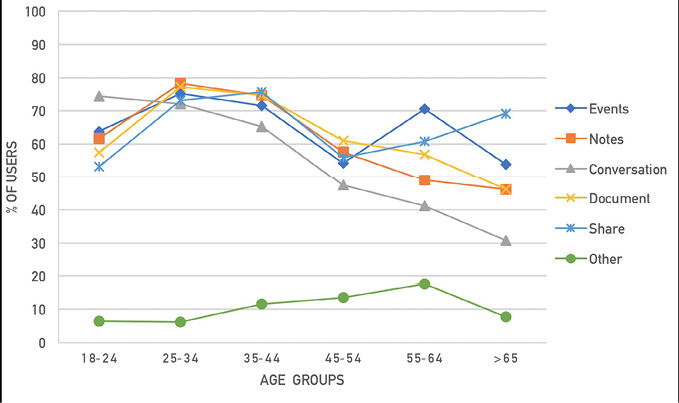
Figure 1. Usage of camera by age.
The usage of camera is very similar between different levels of experience as shown in figure 2. There is only a small difference in the use of a camera at special events (between 14% and 22% compared to the rest of uses) in the group with less than two years of experience. At the same time, users with more years of experience are more likely to use their phones to document spontaneous and everyday moments.
It is also remarkable how 40% of the less experienced users have only one usage of camera, and the users with five usages of the camera represent only 10% of the group (figure 3). However, 44% and 45% of the users with more than 5 years of experience have at least 5 usages for the camera on the phone. It is also statistically significant that users with young kids are more prone to use camera for conversation (16 points of difference and p= 0,31) and Document daily life (17 points and p= 0,001).

Figure 2. Usage of camera by experience with smartphone.

Figure 3. Number of camera usages by experience.
4.2 Origin of the images
Smartphone cameras are still the most common origin of images on the devices, as 95% of the surveyed use it to take photos, followed by WhatsApp and other instant messaging apps used by 90% of the participants. Screenshots are used by 52% of the users, being more common in the younger ones, as 94% of the participants between 18 and 25 years old, use them in contrast to only 15% of participants older than 65. Social networks and e-mail are used by 43% and 42% of the participants respectively. MMS is still used by 9% of the users.
Reviewing the number of image sources it is remarkable that only 5% of participants store in their device pictures exclusively from their camera, being three the most common number of image sources, as it is shown in Figure 4.
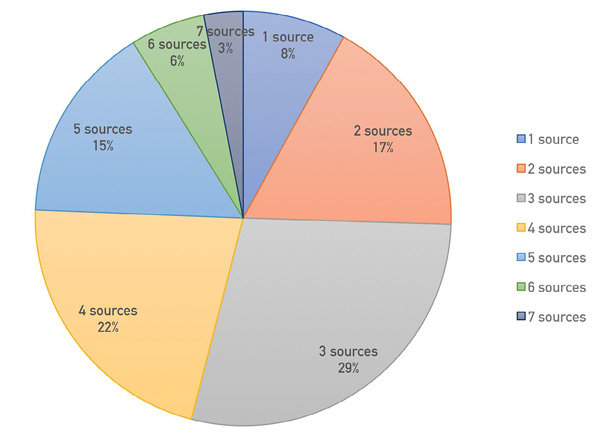
Figure 4. Number of image sources.
Camera and WhatsApp-like apps are very consistent as main source of images among the different levels of experience, while the use of the rest of the sources grow in use as the users increased their experience (figure 5). Users adopt the use of their smartphone as a camera very soon.
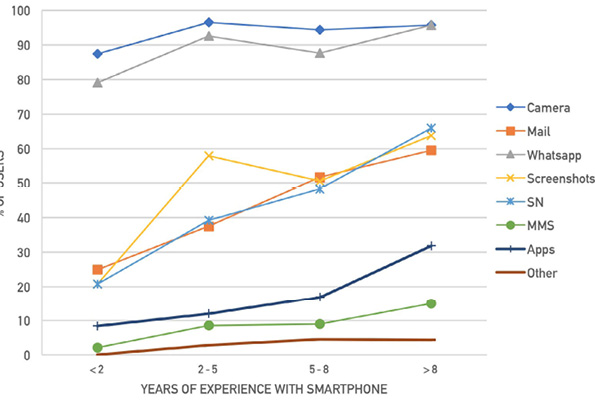
Figure 5. Source of images by experience with smartphone.
4.3 Authorship of the images
After the owner of the smartphone, Friends and Family (72% both) are the most common authors of pictures (figure 6). Only 16% of the participants have pictures exclusively taken by them. The years of experience with mobile phone does not affect directly to the authorship of the images, except for the number of pictures of Unknown author. Authorship diversity showed little changes according to age. Images from celebrities represent only 1%. Fifty three percent of the users have pictures from 3 different groups of authors.
There is a statistically significant difference of 15 points (= 0,001) between the percentage of users with kids under 18 years old that have pictures taken by Family and the ones that don’t have young kids (83% vs. 68%).
4.4 Storage of the images
The results showed that only 12% of users have their photos only in their devices. Phones and computers are the most popular places to store images (figure 6), but if we count them together, as those could be considered the most unsafe places, results show that 31% of the participants do not have their images in any other support. Nearly three fourths of the participants (78%) have more than one storage system.
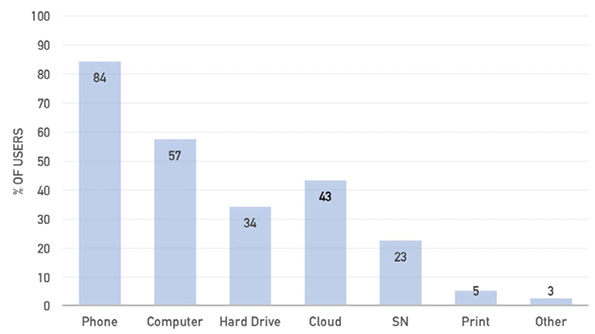
Figure 6. Storage of the images.
The use of social networks as a place to store images is more common in younger, with 45% of the user between 18 and 24 years old versus none in the group over 65. Users with less than two years of experience trust cloud services less than the rest of the groups to store their images (figure 7).
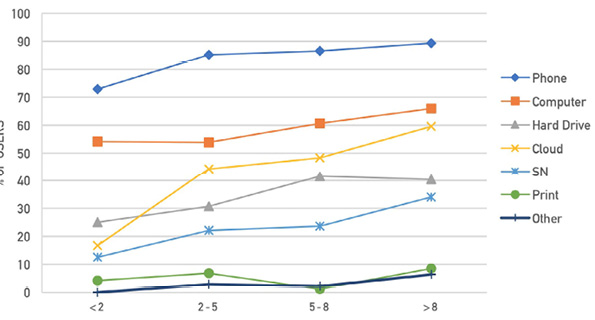
Figure 7. Storage of photos by experience with smartphone.
4.5 Use of the cloud
Dropbox is the most used cloud service for photos with a 38% of the users, this position is extended to all experience levels except for the most experienced users, that trust Google services more. More than one third of the participants (37%) use more than one cloud service.
4.6 Usage of social
The use of social networks decrease with age, except for Flickr and Pinterest that have very similar use in all ages (Figure 8), being Facebook the most common social network people use to store their photos. At the same time, new users trust Facebook and Instagram mainly and try other social networks less. More experience users have more variety of Social Networks, including traditional photo platforms like Flickr.
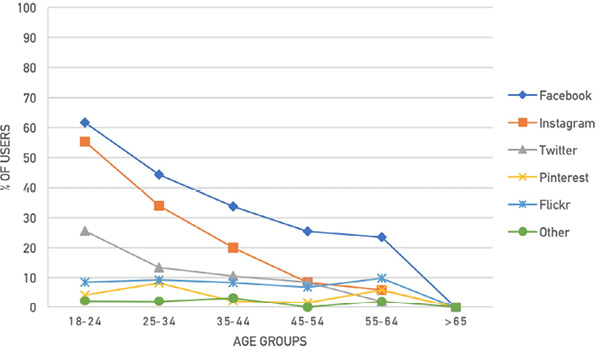
Figure 8. Use of social network by age.
4.7 Image observation of mobile stored photos
Eighty-nine per cent of the users have watched at least once the photos taken with their phone, with no significant difference due to age, experience, gender or paternity.
4.8 Favourite photos
Facing the situation of having to securely store a specific favourite image, 76% of the users save it to a computer. Quite far away is Print, the second option, used by 28% of the users, followed by social networks with19%. Considering age (Figure 9), young people trust social networks, while people older than 55 trust the computer. In relation with printing, 20% (p= 0,000) more women print their favourite pictures than men.

Figure 9. Favourite pictures by age.
4.9 Fate of photos
While asking the participants if they think they would be able to watch the pictures taken with their phones in the future, 54% of them think that most of the pictures in their phones will be probably lost even though only a small percentage (8%) think that those photos are irrelevant. In this subject the experience is an important factor, as only 19% of the users with less than two years of experience think they will be able to check their pictures in the long term while among the users with more than eight years of experience the percentage increase to 39%.
5. Discussion
All the usages of the camera are over 60%, with one third of the participants using all of them. This situation reinforces our hypothesis that people take pictures outside the classic events (Chalfen, 1987; Sarvas & Frohlich, 2011), as some of those usages are new and specific of mobile photography. People with less experience with a smartphone keep using their phone camera as normal camera (Figure 2), following the traditional habits of a user of a domestic camera and focusing more on special events than new usages. At the same time, the more the people are used to having a camera always with them, the more they use it to document moments outside those special events that were traditionally documented and to introduce new habits for their camera use.
The adoption of a smartphone camera as a tool to share moments with absent friends and family (46%) and to talk to friends and family (42%) in users with less than two years of experience is relatively low. In contrast, the adoption of instant message apps like WhatsApp (79%) reinforce the idea that users adapt faster to new technological habits than to new photographic habits, as they start early to share their existing images, probably from some special events, than to make new images that are specific to share on instant messages apps.
That ability to adapt to new apps is shown in the behaviour with social networks, as new users of smartphones are more likely to use the trendiest social networks to store their images, while the users with more experience keep using “old” social networks while joining the new ones. It’s important to remember that users with more than eight years of experience with smartphones, could be considered early adopters (Chesbrough & Kardon Crowther, 2006), so they are more open to try different services, as it was again shown in the number of storage systems they have.
The camera is not the only way people introduce pictures in their smartphones, as only 5% of the participants declare they have only pictures from their camera. Together with the popularity of instant message apps like WhatsApp means that most of the users will have images from, at least, those two sources. Instant message apps also open the door to the increasing number of authors of those images, as it is going to be discussed later.
Screenshot revealed to be a very popular tool in users between 18 and 24 years old, but it decreases rapidly with age, in a similar way to what happens with social networks. The high percentage of young users that capture screenshots, shows how an image source that has no relation with the camera can became popular, adding a new typology of images to the same image flow.
The fact that most of the users have pictures that they have not taken, adds a new variable to image management that most of the systems do not have, as they are based on date, location and face recognition. Together with the popularization of instant message apps, this creates a photo management scenario very different from the one with consumer digital cameras, where users only have to manage their own images (Whittaker, et al., 2009).
The computer is, after the phone itself, the most common place to store the image taken with the mobile phone. And it holds this position through all the ages and years of experience. Confronting this situation with Evans’ (2015) predictions, which state that in 2020 there will be five times more smartphone user than domestic PCs, could lead to a situation where users are going to lose one of their most trusted and habitual devices to store their images. This will force them to adapt their photo management habits to a new mobile-only situation, but also facing the problem of how to review the past images stored on computers and external drives.
As users gain experience they start to trust safer services to store their photos and rely less on traditional solutions like print. This could point to the cloud as the most suitable tool to work as a bridge between computer based photo management and a mobile based photo management.
Despite that, more than half of the users that have their photos stored on the cloud have also a copy on their computers. If we count computer and hard drive, only 31% of the users that have a copy of their photos on a cloud service do not have a local copy. That could lead to believe that there is still a lack of confidence or knowledge from smartphone users on the different cloud services that the main technological companies are offering. All Microsoft, Google, Amazon and Apple offer easy ways to automatically upload user’s images directly from the phone to their clouds, and all those services were active at the time this survey was made.
It is important to mention that cloud is not warranty per se of long time storage. Many photo storage services have closed leaving their users without access to their services and metadata related to those images in some cases, and even without the images in others. In July 2016 an article in The Wall Street Journal cited Lyve, a service that stores the images in a local hard-drive but give access to them through an online platform, as an interesting alternative to store consumer photos (Olivarez-Giles, 2016). Three months later Lyve announces to their user that the service was about to disappear and was shut down on December 2016.
The fact that half of the participants in the survey have at least four different usages of their phone camera, reflects how complicated the photo management on mobile phones is. Users have many different usages of the camera, and that creates different kinds of images that are going to be used in different ways and through different channels.
And it happens the same if we analyse the rest of the point studied in this research. In the case of image source, we found that 75% of the users have at least three different sources for their images. Most of the users have photos they took together with pictures from their family and friends, and those images are generally stored in at least two different places. This level of complexity requires mobile photo management to be much more comprehensive than previous digital photo management, where the source, authorship and storage method used to be unique.
This complexity also reaches the new methods of storage, as more than one third of the participants use more than one cloud service. At the same time, in relation with social networks, it is possible to see how, the more experience the user has, more variety of social networks they use.
That means that photo management should go further than just organising the pictures taken with the camera, because, independently of the number of images that arrive at the mobile phone, it is clear here that there are many channels for the images to reach the phone (figure 5). And unlike in the case of storage safety, which improves with the experience of the user, the complexity of the systems does not seem to improve with the years the user spends with a smartphone. Results show that in most the storage systems there is a slow progress in the number of services related with the years of experience.
Unlike the hypothesis of this research, people do watch their images on their phone. This implies that photo management systems must keep images safe and at the same time allow users to easily review their images.
Pushing the participants to the situation of choosing what to do with an image of special value forces them to perform a manual action that shows their preferences. In that case, most of the participants chose a conservative approach, choosing the computer as the best place to keep their most important images. Comparing these results with the predictions of Evans (2015) they present an even worst scenario, where users will not be able to access their most valuable images. This could help to understand why the second option, chosen by more than one fourth of the participants is to print them, bringing smartphone users to a hundred-year-old solution to a brand-new problem.
The last question sought to find if the users were actually aware of the situation they live in, and the results show how only 28% are confident of being able to see their mobile phone pictures in the future, supporting the idea of frustration that is so present in previous studies (Whittaker, et al., 2009; Miller & Edwards, 2007; Sarvas & Frohlich, 2011; Frohlich, et al., 2002)
It is also visible how new users trust less their smartphones as a long-term use. This might have a relation with the lack of use of safe storage systems and the unfamiliarity of some of current tools to manage images.
6. Conclusions
The ubiquity of the smartphone camera allows new ways of using photography. Users adapt their photo habits to the new possibilities as they gain experience with smartphone use. This experience open possibilities to the user but also creates a more complex photo infrastructure (Sarvas & Frohlich, 2011). This complexity is reflected in all the aspects handled in this research, with an increasing variety of typologies, sources and authorship in snapshot photography.
The specific case of authorship of images require deeper research, as the increase popularity of instant messaging apps is set to increase this variety, and current photo management software is not designed to deal with this new variable.
Most of the users have not yet discovered the advantages that use of the cloud can have in the management and safety of their images. Both the use and the trust in cloud services should improve to allow a smooth and non traumatic transition from computer-based digital photography to a mobile-only system.
The lack of confidence users have in current systems to work as photo archives in the long term do not act as deterrent to use new apps and social networks, but it create frustration.
7. References
Chalfen, R., 1987. Snapshot versions of life. Bowling Green, Ohio: Bowling Green State University Popular Press.
Chesbrough, H. & Kardon Crowther, A., 2006. Beyond high tech: early adopters of open innovation in other industries. R&d Management, 1 6, 36(3), pp. 229-236.
Lindley, S., Durrant, A., Kirk, D. & Taylor, A., 2009. Collocated social practices surrounding photos. Proceeding of the twenty-sixth annual CHI conference extended abstracts on Human factors in computing systems - CHI ‘08, pp. 995-1004.
Bushey, J., 2016. The archival trustworthiness of digital photographs in social media platforms (Doctoral dissertation), Vancouver: The University of British Columbia.
Evans, B., 2015. Mobile: It Changes Everything. [Online] Available at: https://vimeo.com/130722577(Accessed 09 February 2016).
Fetveit, A., 2013. The Ubiquity of Photography. In: Throughout : Art and Culture Emerging with Ubiquitous Computing. Cambridge, MA: s.n., pp. 89-102.
Frohlich, D. et al., 2002. Requirements for photoware. CSCW ‘02 Proceedings of the 2002 ACM conference on Computer supported cooperative work, pp. 166-175.
Hänska, M., 2016. Networked communication and the Arab Spring: Linking broadcast and social media. New Media & Society, January.
Hussain, M. M. & Howard, P. N., 2011. Opening Closed Regimes. Digital Media and Political Engagement Worldwide, pp. 200-220.
Kindberg, T., Spasojevic, M., Fleck, R. & Sellen, A., 2005. The Ubiquitous Camera: An In-Depth Study of Camera Phone Use. IEEE Pervasive Comput. IEEE Pervasive Computing, pp. 42-50.
Kirk, D. S., Sellen, A. J., Rother, C. & Wood, K. R., 2006. Understanding photowork. New York, ACM Press, pp. 761-770.
Marzal, J. & Soler, M., 2011. Hábitos de consumo y usos de la fotografía en la era digital entre estudiantes de Comunicación. Comunicar, 19(37), pp. 109 - 11.
Miller, A. D. & Edwards, K. W., 2007. Give and Take: A Study of Consumer Photo-Sharing Culture and Practice. Proceedings of the SIGCHI conference on Human factors in computing systems - CHI ‘07, pp. 347-356.
Olivarez-Giles, N., 2016. How to Keep Your Photos From Getting Lost in the Cloud. [Online] Available at: http://www.wsj.com/articles/how-to-keep-your-photos-from-getting-lost-in-the-cloud-1468342437 (Accessed 27 December 2016).
Ofcom, 2015. The Communications Market Report, London: Ofcom.
Petrelli, D., Bowen, S. & Whittaker, S., 2014. Photo mementos: Designing digital media to represent ourselves at home. International Journal of Human-Computer Studies, pp. 320-336.
Sarvas, R. & Frohlich, D. M., 2011. From snapshots to social media: The changing picture of domestic photography. New York: Springer.
Siciliano, R., 2012. Almost 5% of Smartphones Lost Every Year. [Online] Available at: https://blogs.mcafee.com/consumer/almost-5-of-smartphones-lost-every-year/(Accessed 20 May 2016).
Van House, N. et al., 2005. The uses of personal networked digital imaging. CHI ‘05 extended abstracts on Human factors in computing systems - CHI ‘05, pp. 1853-1856.
Wells, L., 2000. Photography: a critical introduction. London: Routledge.
Whittaker, S., Bergman, O. & Clough, P., 2009. Easy on that trigger dad: a study of long term family photo retrieval. Pers Ubiquit Comput Personal and Ubiquitous Computing, pp. 31-43.